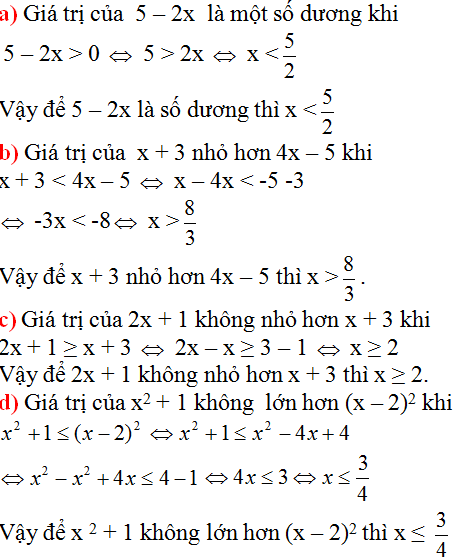Hãy nhập câu hỏi của bạn vào đây, nếu là tài khoản VIP, bạn sẽ được ưu tiên trả lời.

a: \(\dfrac{2x-3}{35}+\dfrac{x\left(x-2\right)}{7}\le\dfrac{x^2}{7}-\dfrac{2x-3}{5}\)
\(\Leftrightarrow2x-3+5x\left(x-2\right)\le5x^2-7\left(2x-3\right)\)
\(\Leftrightarrow2x-3+5x^2-10x< =5x^2-14x+21\)
=>-8x-3<=-14x+21
=>6x<=24
hay x<=4
b: \(\dfrac{6x+1}{18}+\dfrac{x+3}{12}>=\dfrac{5x+3}{6}+\dfrac{12-5x}{9}\)
=>2(6x+1)+3(x+3)>=6(5x+3)+4(12-5x)
=>12x+2+3x+9>=30x+18+48-20x
=>15x+11>=10x+66
=>5x>=55
hay x>=11

\(A=\dfrac{1}{-x^2+2x-2}\)
A min \(\Leftrightarrow\dfrac{1}{A}\)max
ta có \(\dfrac{1}{A}=-x^2+2x-2=-\left(x^2-2x+2\right)=-\left(x-1\right)^2-1\le-1\)
\(\dfrac{1}{A}\)max= -1 tại x=1
=> A min = -1 tại x=1
\(B=\dfrac{2}{-4x^2+8x-5}\) ( phải là -4x2 nha bn)
B min \(\Leftrightarrow\dfrac{1}{B}\) max
ta có \(\dfrac{1}{B}=\dfrac{-4x^2+8x-5}{2}=\dfrac{-\left(4x^2-8x+5\right)}{2}=\dfrac{-\left(2x-4\right)^2+11}{2}=\dfrac{\left(-2x-4\right)^2}{2}+\dfrac{11}{2}\le\dfrac{11}{2}\)
\(\dfrac{1}{B}\)max=\(\dfrac{11}{2}\) tại x=2
\(\Rightarrow B\) min = \(\dfrac{1}{\dfrac{11}{2}}=\dfrac{2}{11}\) tại x=2
\(A=\dfrac{3}{2x^2+2x+3}=\dfrac{3}{2\left(x^2+2.x.\dfrac{1}{2}+\dfrac{1}{4}\right)+\dfrac{5}{2}}=\dfrac{3}{2\left(x+\dfrac{1}{2}\right)^2+\dfrac{5}{2}}\)
A max \(\Leftrightarrow\dfrac{1}{A}\) min
\(\Leftrightarrow\dfrac{2\left(x+\dfrac{1}{2}\right)^2+\dfrac{5}{2}}{3}=\dfrac{2\left(x+\dfrac{1}{2}\right)^2}{3}+\dfrac{\dfrac{5}{2}}{3}=\dfrac{2\left(x+\dfrac{1}{2}\right)^2}{3}+\dfrac{5}{6}\ge\dfrac{5}{6}\)
\(\dfrac{1}{A}\) min = \(\dfrac{5}{6}\)tại x= \(-\dfrac{1}{2}\)
\(\Rightarrow A\)max = \(\dfrac{6}{5}\) tại x= \(-\dfrac{1}{2}\)
B\(=\dfrac{5}{3x^2+4x+15}=\dfrac{5}{3.\left(x^2+\dfrac{4}{3}x+5\right)}=\dfrac{5}{3\left(x^2+2.x.\dfrac{2}{3}+\dfrac{4}{9}+\dfrac{41}{9}\right)}=\dfrac{5}{3\left(x+\dfrac{2}{3}\right)^2+\dfrac{41}{3}}\)
B max \(\Leftrightarrow\dfrac{1}{B}\) min
\(\Leftrightarrow\dfrac{3\left(x+\dfrac{2}{3}\right)^2+\dfrac{41}{3}}{5}=\dfrac{3\left(x+\dfrac{2}{3}\right)^2}{5}+\dfrac{41}{15}\ge\dfrac{41}{15}\)
\(\dfrac{1}{B}\) min = \(\dfrac{41}{15}\) tại x=\(-\dfrac{2}{3}\)
=> \(B\) max = \(\dfrac{15}{41}\) tại x=\(-\dfrac{2}{3}\)
Đây chỉ là gợi ý !! bn pải tự lí luận nha
tik ![]()

điều kiện của x để gtrị của biểu thức đc xác định
=>\(2x+10\ne0;x\ne0:2x\left(x+5\right)\ne0\)
\(2x+5\ne0;x\ne0\)
=>\(x\ne-5;x\ne0\)
vậy đkxđ là \(x\ne-5;x\ne0\)
rút gon giống với bạn nguyen thuy hoa đến \(\dfrac{x-1}{2}\)
b,để bt =1=>\(\dfrac{x-1}{2}=1\)
=>x-1=2
=>x=3 thỏa mãn đkxđ
c,d giống như trên

\(B=\frac{x^2-2}{x^2+1}=\frac{x^2+1-3}{x^2+1}=1-\frac{3}{x^2+1}\)
\(B_{min}\Rightarrow\left(\frac{3}{x^2+1}\right)_{max}\Rightarrow\left(x^2+1\right)_{min}\)
\(x^2+1\ge1\). dấu = xảy ra khi x2=0
=> x=0
Vậy \(B_{min}\Leftrightarrow x=0\)
ta có: \(x^2+2x-2=x^2+2x+1^2-3=\left(x+1\right)^2-3\ge-3\)
dấu = xảy ra khi \(x+1=0\)
\(\Rightarrow x=-1\)
Vậy\(\left(x^2+2x-2\right)_{min}\Leftrightarrow x=-1\)

a) Để giá trị biểu thức 5 – 2x là số dương
<=> 5 – 2x > 0
<=> -2x > -5 ( Chuyển vế và đổi dấu hạng tử 5 )
\(\Leftrightarrow x< \frac{5}{2}\)( Chia cả 2 vế cho -2 < 0 ; BPT đổi chiều )
Vậy : \(x< \frac{5}{2}\)
b) Để giá trị của biểu thức x + 3 nhỏ hơn giá trị biểu thức 4x - 5 thì:
x + 3 < 4x – 5
<=< x – 4x < -3 – 5 ( chuyển vế và đổi dấu các hạng tử 4x và 3 )
<=> -3x < -8
\(\Leftrightarrow x>\frac{8}{3}\)( Chia cả hai vế cho -3 < 0, BPT đổi chiều).
Vậy : \(x>\frac{8}{3}\)
c) Để giá trị của biểu thức 2x +1 không nhỏ hơn giá trị của biểu thức x + 3 thì:
2x + 1 ≥ x + 3
<=> 2x – x ≥ 3 – 1 (chuyển vế và đổi dấu các hạng tử 1 và x).
<=> x ≥ 2.
Vậy x ≥ 2.
d) Để giá trị của biểu thức x2 + 1 không lớn hơn giá trị của biểu thức (x - 2)2 thì:
x2 + 1 ≤ (x – 2)2
<=> x2 + 1 ≤ x2 – 4x + 4
<=> x2 – x2 + 4x ≤ 4 – 1 ( chuyển vế và đổi dấu hạng tử 1; x2 và – 4x).
<=> 4x ≤ 3
\(\Leftrightarrow x\le\frac{3}{4}\)( Chia cả 2 vế cho 4 > 0 )
Vậy : \(x\le\frac{3}{4}\)

Câu b mình viết nhầm dấu \(\ge\)đáng lẽ đúng phải là \(\le\)
a)
\(A=x^2+y^2-x+6y+10.\)
\(=\left(x^2-x+\frac{1}{4}\right)+\left(y^2+6y+9\right)+\frac{3}{4}\)
\(=\left(x-\frac{1}{2}\right)^2+\left(y+3\right)^2+\frac{3}{4}\ge\frac{3}{4}\)
Vậy \(MinA=\frac{3}{4}\Leftrightarrow\hept{\begin{cases}\left(x-\frac{1}{2}\right)^2=0\\\left(y+3\right)^2=0\end{cases}\Leftrightarrow\hept{\begin{cases}x-\frac{1}{2}=0\\y+3=0\end{cases}\Leftrightarrow}\hept{\begin{cases}x=\frac{1}{2}\\y=-3\end{cases}}}\)
b)
\(B=2x-2x^2-5\)
\(=-2\left(x^2-x+\frac{1}{4}\right)+2.\frac{1}{4}-5\)
\(=-2\left(x-\frac{1}{2}\right)^2-\frac{9}{2}\ge-\frac{9}{2}\)
Vậy \(MaxB=-\frac{9}{2}\Leftrightarrow\left(x-\frac{1}{2}\right)^2=0\Leftrightarrow x-\frac{1}{2}=0\Leftrightarrow x=\frac{1}{2}\)


\(A=\dfrac{2x^2-2x+3}{x^2-x+2}=\dfrac{2\left(x^2-x+2\right)-1}{x^2-x+2}=2-\dfrac{1}{x^2-x+2}=2-\dfrac{1}{x^2-2.\dfrac{1}{2}x+\dfrac{1}{4}+\dfrac{7}{4}}=2-\dfrac{1}{\left(x+\dfrac{1}{2}\right)^2+\dfrac{7}{4}}\ge2-\dfrac{1}{\dfrac{7}{4}}=\dfrac{10}{7}\)-Dấu bằng xảy ra \(\Leftrightarrow x=-\dfrac{1}{2}\)